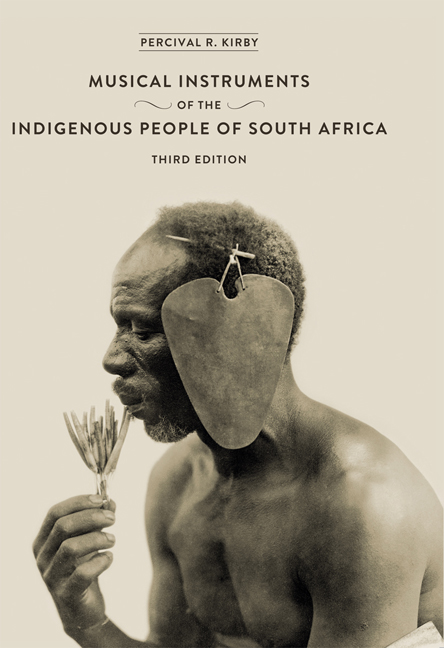Book contents
- Frontmatter
- Dedication
- Map
- Contents
- Foreword
- Preface to First Edition
- Preface to Second Edition
- Acknowledgements
- Acknowledgements to Third Edition
- List of Illustrations
- 1 Rattles and Clappers
- 2 Drums
- 3 Xylophones and ‘Sansas’
- 4 Bull-Roarers and Spinning-Disks
- 5 Horns and Trumpets
- 6 Whistles, Flutes, and Vibrating Reeds
- 7 Reed-Flute Ensembles
- 8 The ‘Gora’, A Stringed-Wind Instrument
- 9 Stringed Instruments
- 10 Bushman and Hottentot Violins and The ‘Ramkie’
- 11 Some European Instruments Played By Natives
- Appendix
- Addenda
- Index
3 - Xylophones and ‘Sansas’
Published online by Cambridge University Press: 21 April 2018
- Frontmatter
- Dedication
- Map
- Contents
- Foreword
- Preface to First Edition
- Preface to Second Edition
- Acknowledgements
- Acknowledgements to Third Edition
- List of Illustrations
- 1 Rattles and Clappers
- 2 Drums
- 3 Xylophones and ‘Sansas’
- 4 Bull-Roarers and Spinning-Disks
- 5 Horns and Trumpets
- 6 Whistles, Flutes, and Vibrating Reeds
- 7 Reed-Flute Ensembles
- 8 The ‘Gora’, A Stringed-Wind Instrument
- 9 Stringed Instruments
- 10 Bushman and Hottentot Violins and The ‘Ramkie’
- 11 Some European Instruments Played By Natives
- Appendix
- Addenda
- Index
Summary
THE most elaborate musical instrument found in South Africa is the resonated xylophone, commonly called marimba. Two varieties are met with, the first among the Venda and the second among the Tshopi. Both are called by the same name, mbila, and both are constructed on the same principle; but the two types are made from different materials, and the two races have each their own manner of performance.
The earliest reference to the instrument that I have been able to discover occurs in Fr. João dos Santos’ description of his visit to eastern Ethiopia in 1586. The people he described were Karanga. The present-day successors of this race do not appear to use the instrument to any great extent, but their South African neighbours, the Venda, certainly do; and it seems to be their form of the instrument, rather than that of the Tshopi, that dos Santos describes with the greatest accuracy and detail in Book I, Chapter 10 of his account.
Quiteve (the chief) makes use of another class of Kaffirs, great musicians and dancers, who have no other office than to sit in the last room of the king's palace, at the outer door, and round his dwelling, playing many different musical instruments, and singing to them a great variety of songs and discourses in praise of the King, in very high and sonorous voices. The best and most musical of their instruments is called the ambira, which greatly resembles our organs; it is composed of long gourds, some very wide and some very narrow, held close together and arranged in order. The narrowest, which form the treble, are placed on the left, contrary to that of our organs, and after the treble come the other gourds with their different sounds of contralto, tenor, and bass, being eighteen gourds in all. Each gourd has a small opening at the side near the end, and at the bottom a small hole the size of a dollar, covered with a certain kind of spider's web, very fine, closely woven, and strong, which does not break. Upon all the mouths of these gourds, which are of the same size and placed in a row, keys of thin wood are suspended by cords so that each key is held in the air above the hollow of its gourd, not reaching the edges of the mouth.
- Type
- Chapter
- Information
- Publisher: Wits University PressPrint publication year: 2013



